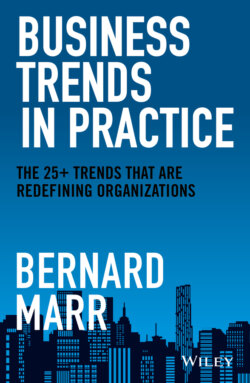Читать книгу Business Trends in Practice - Бернард Марр, Bernard Marr - Страница 14
Trend 5: Social, Cultural, and Workplace Shifts
ОглавлениеI find it fascinating that, while the world seems more polarized than ever, we're also seeing greater convergence between cultures. Think of Hollywood films influencing other cultures, or the global appeal of South Korean boyband BTS, or the way a Chinese teenager's video on TikTok can go viral in the US. Globally, 65 percent of people agree that we have more things in common than things that make us different.29 Yet this is also an age of diversity and individuality; research suggests that individualism is a global phenomenon, not just a Western trend.30 Once again, we see how global trends can contrast with each other.
Let's take a brief look at how society, culture, and the workplace are changing:
Marriage is on the decline, and single-person households are the fastest-growing household profile in the period to 2030.31
The gender gap remains a frustratingly stubborn problem. Women still remain less likely to participate in the labor market than men, are more likely to be unemployed than men, are overrepresented in vulnerable employment, are constrained from achieving the highest leadership positions, and are paid less than men.32 On top of that, it looks as though the socioeconomic impacts of the COVID-19 crisis have disproportionately affected women.33
Closing the gender gap is important, not just for women but for the benefit of society as a whole. There is a strong positive correlation between countries that are successfully closing the gender gap and their economic performance, and narrowing the gender gap means the global income per person will increase by at least 20 percent by 2030.34
The number of Gen Z (those born after 1997) and millennials (Gen Y, born between 1981 and 1996) in the workplace is on the rise and baby boomers are retiring. As the workforce demographic changes, so too do the needs and expectations of workers. To baby boomers, putting in long hours was often seen as essential for success, but those entering the workplace now prioritize flexibility and work–life balance. In this age of personalization and individualism, Gen Z are also looking for an employee experience that is tailored to them. They expect training and mentoring, as well as challenging, meaningful work.35 They increasingly expect to identify with their employer's brand identity; as an example, 65 percent of people want to work for an organization “with a powerful social conscience.”36
How we work is changing, too. One in five global employees now work remotely at least some of the time,37 and the coronavirus pandemic will accelerate this “work from anywhere” culture. (Indeed, major companies like Twitter said early in the pandemic that workers wouldn't have to return to working in the office if they didn't want to.) The pandemic proved that remote working is feasible and beneficial across many industries, and as such we'll see the global job market accelerate – meaning tech workers no longer have to move to Palo Alto and so on.
This work-from-anywhere culture will likely fuel more “free agents” entering the workforce and the continued rise of the gig economy. The hierarchical organizational structures of the past may dwindle in favor of flatter, team- and project-based structures, where people can move between and within organizations depending on where their skills are needed at any one time.
Diversity is also becoming more important as the global job market accelerates, and as more Gen Z-ers (who are more racially and ethnically diverse than previous generations)38 enter the workplace. In a survey by Deloitte, two-thirds of business leaders said diversity was important or very important to their business.39 This includes diversity of thinking, as well as demographic diversity; in fact, diversity of thinking may increase innovation by 20 percent and reduce business risks by 30 percent.40 The high-performing teams of the future, then, will be both demographically and cognitively diverse. Furthermore, organizations with inclusive cultures – where people feel valued, respected, and that they belong – are eight times more likely to achieve better business outcomes and twice as likely to meet or exceed financial targets.41
There's also an increasing emphasis and less stigma around mental health and well-being – another trend that has been accelerated by the pandemic. Going forward, there will be increasing pressure on employers to make sure their people have the right work–life balance and that employees have access to mental health support through third-party providers.
